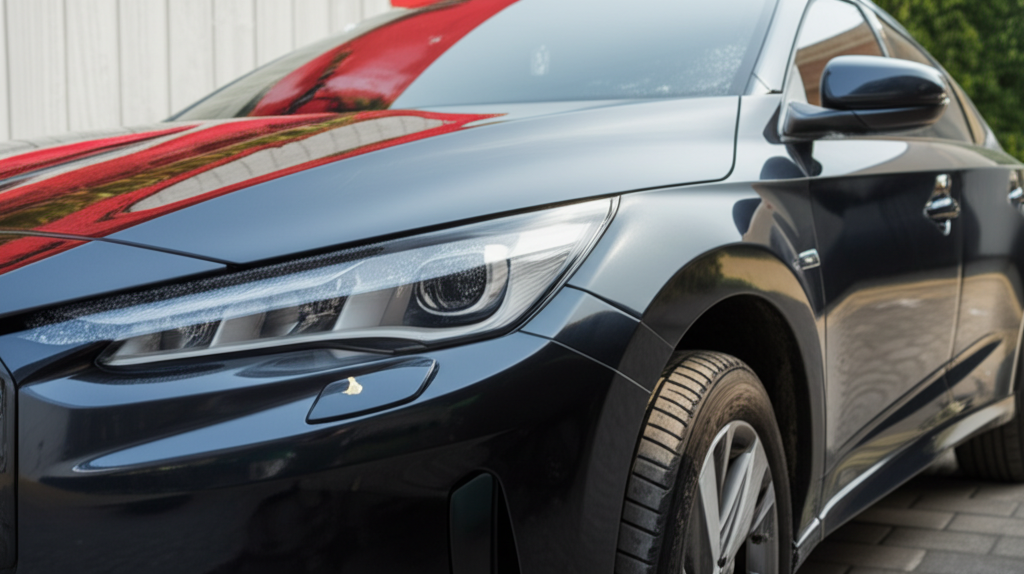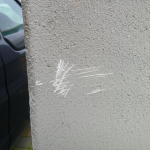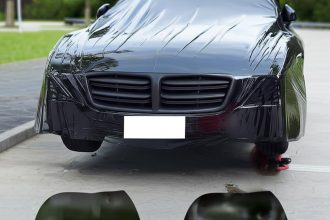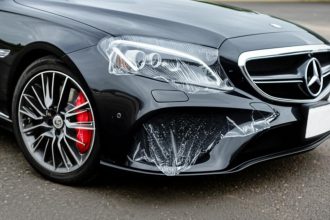So, you’ve just got the keys to your brand-new car! The excitement is palpable. That pristine paint, the new car smell – it’s a significant investment and a symbol of your hard work. Now, you’re planning to put it to work, hitting the busy streets of Bangkok, Chiang Mai, or Pattaya as a ride-share driver. It’s a great way to earn, but a nagging thought might be creeping in: with constant daily use, navigating tight city traffic, passengers hopping in and out, and unpredictable road conditions, how long will that perfect finish last? The fear of scratches, stone chips, swirl marks, and general wear and tear becoming a daily reality is genuine. Every trip adds mileage, but also potential blemishes that can quickly diminish your car’s look and value. Is there a way to protect your investment and maintain that showroom shine while maximizing your earning potential?
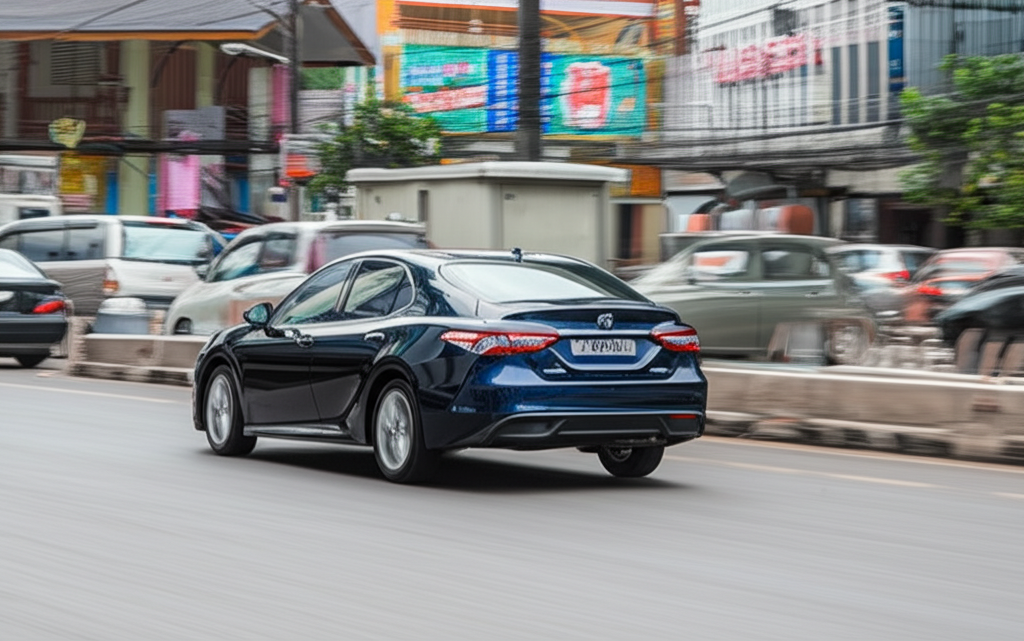
Real Story: Somchai’s Peace of Mind on Bangkok Roads
Meet Somchai. He recently purchased a gleaming new Honda City, planning to supplement his income by driving for Grab during evenings and weekends in Bangkok. Within the first month, reality hit. He noticed small scratches near the door handles (likely from passengers’ rings or bags), a few tiny chips on the front bumper from gravel on the highway stretches, and the beginning of swirl marks from frequent washing needed to keep the car presentable for customers. “I was washing the car almost every other day, trying to keep it looking professional,” Somchai shared, “but I realised I was probably causing more fine scratches. And every time I heard gravel hit the front, my heart sank a little. This car is my asset, I needed to protect it.”
After researching online and talking to fellow ride-share drivers, Somchai decided to invest in a high-quality Thermoplastic Polyurethane (TPU) Paint Protection Film (PPF). He opted for partial front coverage (full bumper, partial hood, front fenders, side mirrors) plus door cups and door edges – the areas he identified as most vulnerable in his daily driving routine. The installation took a day, professionally applied by a local specialist. “The difference wasn’t just visual, though the car looks incredibly glossy now,” Somchai explains. “It’s the peace of mind. I still drive carefully, but I’m not constantly stressed about every little piece of debris or a passenger accidentally brushing against the door. Cleaning is easier too; dirt and bug splatters just wipe off the film. It feels like the car has armour, ready for the daily grind.”

Understanding Your Protection Options: TPU PPF Explained
When it comes to protecting your car’s paint, especially in high-use scenarios like ride-sharing, you have several options. Traditional waxes and sealants offer minimal protection against physical damage and wear off quickly. Ceramic coatings provide excellent gloss, hydrophobicity (water-repelling), and some resistance to chemical etching and very light scratches, but they offer little defence against stone chips or deeper scratches. Then there’s Paint Protection Film (PPF).
PPF is a transparent or coloured urethane film applied directly to the vehicle’s painted surfaces. While older or cheaper films might be made of PVC (Polyvinyl Chloride), the gold standard today, especially for durability and clarity, is TPU (Thermoplastic Polyurethane). TPU films are known for their flexibility, transparency, resistance to stains and discolouration (non-yellowing), and, crucially for many, their self-healing properties. Minor scratches and swirl marks on the film can often disappear with exposure to heat (like the sun or warm water).
For a ride-share driver clocking up kilometres daily in Thailand’s demanding environment (think heat, intense sun, sudden rain, traffic grit, and frequent passenger turnover), TPU PPF offers a robust shield against the most common forms of paint damage:
- Stone Chips: Protects leading edges like the bumper, hood, and fenders from impacts.
- Scratches: Guards against accidental scratches from keys, bags, jewellery, car washes, and tight parking spots.
- Bug Splatter & Bird Droppings: Creates a barrier against acidic substances that can etch paint.
- Minor Bumps & Abrasions: Offers a sacrificial layer against light scuffs and parking mishaps.
- UV Radiation: Quality TPU films contain UV inhibitors, helping to prevent paint fade from Thailand’s strong sun.
- Environmental Contaminants: Resists damage from tree sap, road tar, and acid rain.
Let’s compare TPU PPF with other common options:
| Feature | TPU PPF | Ceramic Coating | Wax / Sealant | PVC Film |
|---|---|---|---|---|
| Impact/Scratch Protection | High (Absorbs impact, resists scratches) | Low (Resists very light swirls/micro-scratches) | Very Low / None | Medium (Can protect but less durable/flexible than TPU) |
| Self-Healing (Minor Scratches) | Yes (Most quality TPU) | No | No | No (or very limited) |
| Durability / Lifespan | 5-10+ Years (with proper care) | 1-5+ Years (depending on product/maintenance) | Weeks / Months | 1-3 Years (Prone to cracking/yellowing sooner) |
| UV Protection | Yes (Helps prevent paint fade) | Yes (Good UV resistance) | Minimal / Temporary | Variable (Can degrade/yellow under UV) |
| Clarity / Appearance | Excellent (Optically clear, enhances gloss) | Excellent (High gloss, enhances depth) | Good (Adds temporary gloss/wet look) | Fair to Good (Can have ‘orange peel’ texture, prone to yellowing) |
| Stain / Chemical Resistance | High | High | Low | Medium |
| Ease of Cleaning | High (Hydrophobic top coats common) | Very High (Very hydrophobic) | Medium (When freshly applied) | Medium |
| Cost (Initial Investment) | High | Medium to High | Low | Low to Medium |
| Best Suited For | Maximum physical protection, high-mileage drivers, preserving resale value. Ideal for ride-share. | Gloss, ease of cleaning, protection from environmental contaminants. Good supplement to PPF. | Budget-conscious owners, temporary gloss enhancement. Requires frequent reapplication. | Short-term or budget protection, less demanding use cases. Not ideal for long-term or harsh conditions. |
For someone relying on their car for income, the higher upfront cost of TPU PPF often translates into better long-term value by preventing costly paint repairs, maintaining a professional appearance for customers, and preserving the vehicle’s resale value.
Voices from the Road: Ride-Share Drivers on PPF
“Driving my Toyota Yaris Cross daily for Bolt in Phuket means lots of narrow roads and tourist traffic. Getting full front TPU film was the best decision. I used to cringe at gravel roads, now I barely think about it. Already deflected a few nasty stone chips that would have definitely needed a touch-up.” – Preeya S.
“My passengers often have luggage. Before PPF, I was always worried about them scratching the rear bumper loading things in and out of my MG ZS. I got the rear bumper top and door edges filmed. Total peace of mind now. Plus, the car still looks showroom fresh after 8 months of daily ride-sharing in Chiang Mai.” – Niran C.
“Honestly, I debated the cost for my new Nissan Almera. But seeing friends spend money on fixing little scratches every few months convinced me. The self-healing aspect of the TPU film is amazing. Minor scuffs from bushes on rural roads just vanished in the sun. It feels like a smart investment for my business.” – Artit P.
The common thread? Initial apprehension about the cost transforms into relief and satisfaction. Drivers feel less stressed, their cars stay looking newer for longer, and they see it as a worthwhile investment in their primary work tool.
Protect Your Investment, Protect Your Income
Your new car is more than just transport; it’s your mobile office, your income generator, and a significant financial asset. Subjecting it to the high demands of daily ride-sharing in Thailand without adequate protection is risking its appearance, value, and potentially incurring repair costs that eat into your profits. TPU Paint Protection Film offers a tangible solution – a durable, nearly invisible shield that takes the brunt of the daily abuse, leaving your original paint pristine underneath.
Stop worrying about every stone chip, potential scratch, or harsh sun exposure. Invest in protecting your vehicle’s future today. Explore the options for TPU PPF coverage that best suit your car and driving patterns.
Ready to give your ride-share vehicle the protection it deserves? Contact us for a consultation and personalized quote.
📱 Want to learn more about car wrap & paint protection?
Feel free to reach us on LINE:

🌐 Official Website: https://tpuwraps.com
Frequently Asked Questions (FAQ)
- Q: Is TPU PPF really necessary if I’m a careful driver?
- A: Even careful drivers can’t avoid road debris kicked up by other vehicles, unexpected hazards, or accidental bumps/scratches from passengers or in parking lots. For high-frequency driving like ride-sharing, the exposure risk is significantly higher, making PPF a highly recommended preventative measure.
- Q: How long does quality TPU PPF last in Thailand’s hot and humid climate?
- A: Reputable TPU PPF brands installed professionally can last anywhere from 5 to 10 years or even longer. Longevity depends on the film quality, installation expertise, and how well you maintain it (regular washing, avoiding harsh chemicals). Thailand’s climate necessitates a quality film with good UV inhibitors and stain resistance.
- Q: Will PPF damage my car’s original paint?
- A: No, professionally installed and removed quality TPU PPF will not damage your factory paint. In fact, it protects it. Issues usually arise only from poor installation techniques, low-quality films, or improper removal methods.
- Q: What’s the main difference between TPU and cheaper PVC films?
- A: TPU is superior in almost every way. It’s more flexible (easier installation on curves), more durable, optically clearer, resistant to yellowing/cracking, and often has self-healing properties. PVC films are typically thicker, less clear, can yellow or crack relatively quickly, especially in strong sun, and lack self-healing capabilities. While cheaper initially, PVC often needs replacement much sooner.
- Q: How much does TPU PPF installation cost in Thailand?
- A: The cost varies significantly based on the car size, the amount of coverage desired (e.g., front bumper only, partial front, full front, full car), the specific brand of PPF chosen, and the installer’s labour rates. For a partial front kit on a typical sedan, expect prices to range from ฿15,000 to ฿40,000+ THB, while a full car wrap can cost considerably more. It’s best to get specific quotes for your vehicle and needs.
Conclusion: Drive Confidently, Earn Smarter
Embarking on a ride-sharing venture with a new car in Thailand is exciting. Don’t let the constant worry about paint damage overshadow the opportunity. Protecting your vehicle with high-quality TPU Paint Protection Film is a proactive step towards maintaining its aesthetic appeal, preserving its resale value, and ultimately, reducing stress and potential repair costs. It’s an investment in your business asset that allows you to focus on providing excellent service and maximizing your earnings, mile after mile. Drive confidently, knowing your car’s paintwork is shielded against the challenges of the road.
